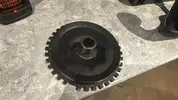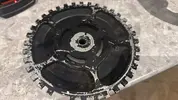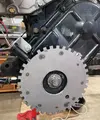There is more to life with TurboRenault.co.uk
You are using an out of date browser. It may not display this or other websites correctly.
You should upgrade or use an alternative browser.
You should upgrade or use an alternative browser.
Alpine 1968 Renault R8
- Thread starter Adey
- Start date
- Featured
Wheelers Workshop
Active Member
Hi Steve,@Renoholic . I think there must be some harmonic effect that causes the cracking. The reason Burton did the solid steel pulleys for the crossflow, is that their originals are prone to cracking and are also pressed. The pressing must create stresses in the metal which is then harmonically destroyed by the crankshaft. Especially at high RPM. Now who here uses high RPM except you, me and @Wheelers Workshop.
@Adey. Renoholic AKA Frans has been racing R8's for a long time and his results prove just how well they punch above their weight, when properly sorted.
I don't profess to fully understand the crank harmonics issues, but after previously chatting with Salv many years ago regarding lightening cranks, which apparently some people do with an angle grinder, he advised me to leave all alone. So I have always used the 2 part pressed steel factory pulley as Frans shows in his pics, the only failure I have had, is that the 2 central boss slots wore away as did the male tab in the pulley, but I think that was due to a loose crank bolt. I replaced all the parts and locktited the big bolt insitu so far all has been OK again. Salv recently showed me his new steel cranks beautifully manufactured and finished and these have additional balance weights comparted to std units.
What puzzles me the most is that the 1598cc K4M RS unit I am playing with has a dirty great big heavy pulley just for the serpentine auxillary drive belt and its got a stiff rubber flexible band internally within the pulley, this fouls the R8G tubular brace bar so I will have to think about a replacement V belt pulley at some stage. The heavy factory flywheel has the toblerone blocks for the ignition sensor, but the flywheel I am now using on the K4M is a std R5G 180mm clutch item, naturally its been lightened by Salv.
My South African built R8g came with a cast solid crank pulley, which Frans and Carvel have seen pictures of, and is quite similar to the Burton Ford Crossflow item about 4" in diameter, and is showing a Renault Diamond and a date of 1969.
I previously have read about factory tin pullies which are spot welded together, can at high rpm part company, I assume that is why solid ones are available for competition use, I am also toying with the idea of a toothed belt drive system for the K4M Water pump , alternator and crank pulley, the toothed crank pulley should be capable of resisting breaking up.
Anyone have any thoughts/comments regarding harmonics?
Cheers
Dave .
Nearly all the modern Renaults have a similar pulley setup with rubber insert. I'm not sure if its there for harmonics or loading of the pulley with everything they tend to run (AC pas alt). I do know that some of the "racier" built engines ditch it in favour of a solid aluminium item.
Steve Swan
Well-Known Member
It's probably so it can fly to bits on you when you least expect/need it to. All engines are in effect a huge impact gun, we tend not to think of them as such, when you get involved in Dyno couplings you begin to see them in a different light. Damnedest thing I ever saw was a Jag V6 atmo making about 400hp cause the coupling shaft to go blue with heat in the middle of the shaft, for no apparent reason. If you had not witnessed it you would have said it was not possible. Mini A series are a pain in the Ass also, for breaking couplings. This is why we frequently have timing belts instead of chain or gears, there's no rule of thumb. It's a branch of science I know is there, but have no real understanding of, other than to beware of it.........
sparkie
Well-Known Member
Could you not use a gt turbo pulley and instead of welded something to it, create the 'tooth' pattern by drilling holes into it and mounting the sensor perpendicular to the pulley surface? So you've got a series of gaps to simulate a tooth trough and metal between holes to simulate a tooth peak?
Brigsy
Media Mogul. Instagram legend.
Welded gtt crank pulley with 36-1 trigger wheel is usually fine for all the rpm, never seen a gtt crank pulley fail when done.
Other option is get ttv to make a flywheel with 36-1 or 60-2 trigger pattern on and mod bellhousing to fit a crank sensor to. Assuming doable with the gtt conversions done on Paul's r8.
Other option is get ttv to make a flywheel with 36-1 or 60-2 trigger pattern on and mod bellhousing to fit a crank sensor to. Assuming doable with the gtt conversions done on Paul's r8.
Steve Swan
Well-Known Member
Don't forget the important point of trying to slow things down. Standard pulleys good for standard engines, but if the RPM is going to climb then not over speeding the water pump and fan is a good thing and worth more hp across the rev range than mapped ignition would give. The ignition is a fantastic idea as a precursor to turbocharging, so I'll say no more........
Brigsy
Media Mogul. Instagram legend.
Don't forget the important point of trying to slow things down. Standard pulleys good for standard engines, but if the RPM is going to climb then not over speeding the water pump and fan is a good thing and worth more hp across the rev range than mapped ignition would give. The ignition is a fantastic idea as a precursor to turbocharging, so I'll say no more........
C3j pulley is smaller so would be the better option over the larger gtt pulley. Works well for 7600rpm, never had a belt come off. Never sat down and worked out pulley speeds but everything works well enough.
What rpm are the n/a stuff turning?
Steve Swan
Well-Known Member
True, but you're not turning a 6 blade propeller, using around 5-6 shaft hp, which is a vital part of the cooling system. You either keep it, and it is a bulletproof solution up to over 150 hp, or you go front rad with all it entails, which is a load of work. You used to be able to hear the propeller on Liz's 8 as it passed the pits at Knockhill around 7-7.5k. dropping the pulley to the 4" Ford item slowed it enough that it became silent. Any fan/impellor if overspeeded will start to cavitate and loose efficiency. This is another branch of Science I understand is there , but don't fully understand. A domestic central heating pump will pump hot water around 15 radiators in a large house on 1350rpm . A car waterpump at 6000rpm has lost most of it's usefulness. If you look at the Davies Craig electric waterpump tech spec it's interesting the general lack of rpm required. I know it is a slightly more efficient design, but it is a classic case of less is more...C3j pulley is smaller so would be the better option over the larger gtt pulley. Works well for 7600rpm, never had a belt come off.
What rpm are the n/a stuff turning?
How's your turbo theory knowlege ?? I am looking to replace the turbo on the Landy and am finding the level of sales blurb a bit confusing. I'll post it up on the Landy thread as I've put up enough rubbish here..... Sorry @Adey
Brigsy
Media Mogul. Instagram legend.
Interesting that, forgot they run the pump mounted propellor. Never worked on any of the older rear engined stuff ill admit.
Ive been looking into a ribbed aux belt setup for mine as i need an alternator upgrade ideally with all the additional electrics. Its on the never ending list of things to do.
Ive been looking into a ribbed aux belt setup for mine as i need an alternator upgrade ideally with all the additional electrics. Its on the never ending list of things to do.
I put a more modern alternator on my 8 when i changed the engine but removed the ribbed pully and put a v belt pully in its place , seem to remember it being off a laguna . Thought everyone was fitting the tiny alternators off kubota mini diggers at one point lolInteresting that, forgot they run the pump mounted propellor. Never worked on any of the older rear engined stuff ill admit.
Ive been looking into a ribbed aux belt setup for mine as i need an alternator upgrade ideally with all the additional electrics. Its on the never ending list of things to do.
lol nooooo you've all scared me too much over the gearbox to go turbo!!!Don't forget the important point of trying to slow things down. Standard pulleys good for standard engines, but if the RPM is going to climb then not over speeding the water pump and fan is a good thing and worth more hp across the rev range than mapped ignition would give. The ignition is a fantastic idea as a precursor to turbocharging, so I'll say no more........
I've been doing some reading around and didn't want to go nuts on the ecu side of things (and the cost of it) to only use the ignition side of an all singing ecu. ME (Motorsport Electronics) sell a ignition only ecu, small easy to use and upgradable to a point. Looks simple enough and capable enough for the 8's current setup. It can run as simply as a controlled ignition setup using just rpm for timing, though I'm going to go with a map sensor (so could possibly run boost in the future

Renoholic
Active Member
To continue with the new trigger wheel fabricate and install as promised, I have the following photos to tell the story. @Adey you can see the trigger wheels that I got and because the sensor was mounted at 90 degrees to the wheel I used 2mm steel, but now with the smaller pulley I decided to mount the sensor inline with the wheel so I did go a little thicker. I have now got 2 x trigger wheels 3mm thick and just for safety I have 2 x trigger wheels 4mm thick. I will use the 3mm wheels but if the detection isn't good enough I have the 4mm to go on.
I got the Ford pulley and machined the back of it a little thinner to get a step in the surface that will centralise the wheel and at the same time it gives me a little more body to drill and tap the mounting holes.
Follow the photos that will tell the story.
Here are the two wheels drilled and countersunk. One 3mm and the other 4mm.
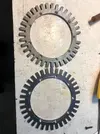
Here is the pulley, drilled and tapped. Note the step I machined to center the trigger wheel.

Three screws in, six to go.

Spares anybody?

Regards.
I got the Ford pulley and machined the back of it a little thinner to get a step in the surface that will centralise the wheel and at the same time it gives me a little more body to drill and tap the mounting holes.
Follow the photos that will tell the story.
Here are the two wheels drilled and countersunk. One 3mm and the other 4mm.

Here is the pulley, drilled and tapped. Note the step I machined to center the trigger wheel.

Three screws in, six to go.

Spares anybody?

Regards.
Steve Swan
Well-Known Member
Nice work as always Frans. Hope this behaves for the season ahead.. Good luck.
@Renoholic would love to see more of the car, do you have a build thread anywhere?
Renoholic
Active Member
I have put some info on a few years ago about the race car in this first link but more detail of the engine work similar to the race car in my restoration link.@Renoholic would love to see more of the car, do you have a build thread anywhere?
It all started in South Africa where the Gordini was like a cult car. I have a few scanned photos to put up. This one was very hot and highly modified 1480 race car completely stripped out with 10" Michellin slicks. It was quicker that the restored Ford Mustang from our Saloon car champion of circa 1968. Fly wheel hp peaked at 155 @ 8500 rpm. My last race was in April 2001 just before we emmigrated to NZ and I out qualified the Mustang and out raced it as well.
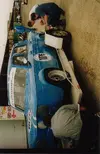
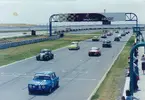
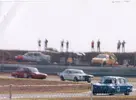
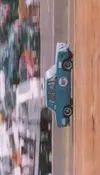
That's all I have from that car. I have to mention that it wasn't mine...




That's all I have from that car. I have to mention that it wasn't mine...
- Renoholic
- gordini racing
- Replies: 22
- Forum: Classic project threads
Me and my son came across a Matra Jet 6 for sale and he decided to buy this car and import it to NZ. The Matra history is quite a lengthy one and very interesting for me. What makes it outstanding is that with its design in 1962/63 Rene Bonnet built it as a true mid engined car. The very first, beating the likes of De Tomaso, Ferrari and Lamborghini. Being a good engineer and bad accountant he was soon in debt with MATRA from whom he rented workshop space and they did the body for him as MATRA had a lot to do with missiles and weaponry and aircraft. They decided to take him over instead of...
- Renoholic
- restoration
- Replies: 20
- Forum: Classic project threads
Regards.
Steve Swan
Well-Known Member
Or if you want to loose a couple of Days, join up to Aussiefrogs forum and read all about it. 2 new racecars in NZ, is Frans usual thread following the trials and tribulations of trying to race on a budget....
Renoholic
Active Member
The trigger wheel is now complete and assembled. I had to shorten the pulley by 10mm to match the Renault fit.
With one tooth missing the balance must surely be out. The faster you go the more the missing tooth is going to have an influence. So I measured it, 5mm wide x 10mm long. That equals 50 square mm. I then did some more calculations and found that if I drill 1 x 4mm hole and 2 x 5mm holes on the opposite side, I would have removed 51.76 square mm. The small difference is good because the holes are not exactly in the same radius. That 1.76 square mm extra will compensate more or less for the smaller radius. Whichever way, it will be more balanced than it would have been.
This is the completed wheel with the screws Loctited in. What's left is the sensor re-positioning.
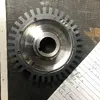
Regards.
With one tooth missing the balance must surely be out. The faster you go the more the missing tooth is going to have an influence. So I measured it, 5mm wide x 10mm long. That equals 50 square mm. I then did some more calculations and found that if I drill 1 x 4mm hole and 2 x 5mm holes on the opposite side, I would have removed 51.76 square mm. The small difference is good because the holes are not exactly in the same radius. That 1.76 square mm extra will compensate more or less for the smaller radius. Whichever way, it will be more balanced than it would have been.
This is the completed wheel with the screws Loctited in. What's left is the sensor re-positioning.

Regards.
Wheelers Workshop
Active Member
Hi Steve,True, but you're not turning a 6 blade propeller, using around 5-6 shaft hp, which is a vital part of the cooling system. You either keep it, and it is a bulletproof solution up to over 150 hp, or you go front rad with all it entails, which is a load of work. You used to be able to hear the propeller on Liz's 8 as it passed the pits at Knockhill around 7-7.5k. dropping the pulley to the 4" Ford item slowed it enough that it became silent. Any fan/impellor if overspeeded will start to cavitate and loose efficiency. This is another branch of Science I understand is there , but don't fully understand. A domestic central heating pump will pump hot water around 15 radiators in a large house on 1350rpm . A car waterpump at 6000rpm has lost most of it's usefulness. If you look at the Davies Craig electric waterpump tech spec it's interesting the general lack of rpm required. I know it is a slightly more efficient design, but it is a classic case of less is more...
How's your turbo theory knowlege ?? I am looking to replace the turbo on the Landy and am finding the level of sales blurb a bit confusing. I'll post it up on the Landy thread as I've put up enough rubbish here..... Sorry @Adey
Well we have kicked the "can up the road" regarding this one, but I thought that I would just mention that our own similar engined R8 Competition cars were built for slightly different disciplines, mine is a driven on the road car, and on my long hours of driving to France for hillclimb events, I often travel a night so the electrical demand on the modern " Kubota" type alternator and similar design ones I have been using [50amp] is considerable with all the lights on and in traffic ques both rad fans being on as well, there is also the electric fuel pump the 2 speed heater fan as well not forgetting the 2 speed wipers if its raining, so any stop like a big que or road works would drain my battery with the little 107mm od African cast pulley on, as the voltage gauge would quickly sink into the red zone and take a long time to recover into the green zone. So now I have to use the Std size 2 part crank pulley [132mm od]. The current Matiz 65 amp Alternator pulley is 74mm od I also change the drive belt annually as well and meticulously check it regularly for tension and alignment. and I do not run the std R8 Steel cooling fan either.
Despite all the above, when I previously run a std 8G rear rad and the std steel fan, I did notice a lot of rubber dust deposits around the engine bay;
I later deduced that the R8 with a "modern compact" alternator set up is not ideal due to the proximity of the water pump and the N/S crossmember / engine mounting which restricts the arc of alternator adjustment, luckily belts are available in small increments in diameter.. The compromise is the smaller the alternator or crank pulley, the less of the V belt contact with the pulley sides.
Finally, the R5GTT block I use has to have the n/s engine mounting boss locally ground down otherwise the alternator contacts it further reducing its already restricted arc of travel.
Skipping forward to the Project RS133 K4M 1598cc unit I am still playing with, it will require for a new Crank pulley design, which I would like to incorporate a toothed belt drive and as there is no water pump involved it all seems simpler to design, oddly these K4M blocks despite being transversely located in the donor FWD cars, still have the big n/s R8 boss present and its also drilled for the M10 alternator fixing bolt , how weird is that. I have also now procured an early 1600cc Clio 8Valve Energy engine sump and its new oil pump, this engine design being pre 16V and which originally had the exhaust manifold facing forward and with the downpipe then passing 90deg under the engine towards the rear, the sump which is very shallow at that point and looks similar to a Ford x flow sump etc.
The 8 Valve all alloy oil pump while being of a similar design to the later 16v versions , is angled to be more vertical to suit the 8 valve sump bowl location , it will still have to be shortened by approx -35mm but being an alloy tapered tube will not easily lend itself to be cut and shut, so I now have a Ford V4 steel oil pick up tube and gauze to play with, which just leaves how to attach it into the tapered pump body. But that's another story.
Cheers
Dave
Similar threads
- Question
Other ( non boosted Renault )
R8 5 speed gearbox (again)
- Replies
- 9
- Views
- 150
- Featured
- Replies
- 82
- Views
- 2K
- Replies
- 21
- Views
- 1K

